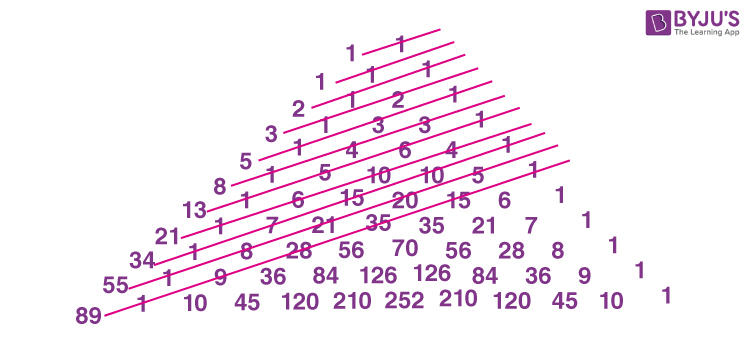Fibonacci Series In Discrete Mathematics
In Maths, the Fibonacci numbers are the numbers ordered in a distinct Fibonacci sequence. These numbers were introduced to represent the positive numbers in a sequence, which follows a defined pattern. The list of the numbers in theFibonacci series is represented by the recurrence relation: 0, ane, one, two, 3, 5, 8, xiii, 21, 34, 55, ……..,∞. In this article, let us hash out what is a Fibonacci number, properties, Fibonacci formulas and series in detail.
What is Fibonacci Number?
A Fibonacci number is a serial of numbers in which each Fibonacci number is obtained by adding the ii preceding numbers. It ways that the side by side number in the series is the improver of two previous numbers. Let the commencement two numbers in the series be taken as 0 and 1. By adding 0 and 1, we become the third number as 1. Then by adding the 2d and the third number (i.e) 1 and ane, we become the fourth number as ii, and similarly, the process goes on. Thus, we become the Fibonacci serial equally 0, ane, 1, 2, 3, v, 8, ……. Hence, the obtained series is called the Fibonacci number serial.
We can also obtain the Fibonacci numbers from the pascal's triangle as shown in the below figure.

Hither, the sum of diagonal elements represents the Fibonacci sequence , denoted by colour lines.
Fibonacci Series List
The list of numbers of Fibonacci Sequence is given beneath. This listing is formed by using the formula, which is mentioned in the above definition.

Fibonacci Numbers Formula
The sequence of Fibonacci numbers can exist defined as:
Fdue north = Fn-1 + Fn-2
Where Fn is the nth term or number
Fn-i is the (n-ane)thursday term
Fn-2 is the (n-ii)th term
From the equation, we can summarize the definition as, the next number in the sequence, is the sum of the previous two numbers present in the sequence, starting from 0 and 1. Let us create a table to find the next term of the Fibonacci sequence, using the formula.
| Fn-1 | Fn-2 | Fn |
| 0 | 1 | 1 |
| 1 | 1 | ii |
| i | ii | 3 |
| 2 | three | five |
| three | 5 | eight |
| 5 | eight | 13 |
| 8 | thirteen | 21 |
| 13 | 21 | 34 |
| 21 | 34 | 55 |
| 34 | 55 | 89 |
In the above table, yous tin can come across the numbers in each column are relational and diagonally the numbers are the same in all the three columns.

Fibonacci Number Properties
The following are the backdrop of the Fibonacci numbers.
- In the Fibonacci series, take whatever three sequent numbers and add together those numbers. When you divide the result by 2, you will go the three numbers. For instance, take 3 sequent numbers such as 1, 2, iii. when you add together these numbers, i.due east. i+ 2+ 3 = half-dozen. When six is divided by ii, the effect is 3, which is 3.
- Accept 4 consecutive numbers other than "0" in the Fibonacci serial. Multiply the outer number and likewise multiply the inner number. When yous subtract these numbers, you volition go the difference "1". For example, take 4 consecutive numbers such as 2, three, five, eight. Multiply the outer numbers, i.e. 2(8) and multiply the inner number, i.e. three(5). Now subtract these two numbers, i.due east. xvi-15 =ane. Thus, the difference is 1.
Fibonacci Numbers Examples
Question 1:
Write the first half dozen Fibonacci numbers starting from 0 and ane.
Solution:
As we know, the formula for Fibonacci sequence is;
Fn = Fn-1 + Fn-2
Since the first term and second term are known to u.s., i.e. 0 and i. Thus,
F0 = 0 and F1 = one
Hence,
Third term, Fii = F0 + Fone = 0+1 = ane
Fourth term, F3 = F2+F1 = ane + ane = 2
Fifth term, F4 = F3+Ftwo = one+2 = three
Sixth term, F5 = F4+F3 = 3 + two = 5
So, the commencement six terms of Fibonacci sequence is 0,1,1,2,3,5.
Question 2:
Discover the next term of Fibonacci series: 0, ane, 1, ii, 3, 5, viii, 13, 21, 34.
Solution:
Each next term of the Fibonacci serial is the sum of the previous two terms.
Therefore, the required term is;
21 + 34 = 55
Watch the Below Video to understand the Fibonacci Numbers and Gold Ratio

To learn more of import mathematical concepts, please download BYJU'Due south -The Learning App and watch more than interesting videos.
Oftentimes Asked Questions – FAQs
What are the outset 10 Fibonacci numbers?
The start 10 Fibonacci numbers are given by:
1, 1, two, 3, 5, viii, 13, 21, 34, and 55
What are the numbers in the Fibonacci sequence?
The Fibonacci sequence contains the numbers as: 0, 1, 1, 2, 3, v, 8, thirteen, 21, 34, 55, …,∞
What are Fibonacci numbers used for?
Fibonacci numbers play an essential part in financial assay. Here, the Fibonacci number sequence can be used to generate ratios or percentages that are useful for business people.
What are the starting time 12 Fibonacci numbers?
The first 12 Fibonacci numbers are given past:
1, 1, 2, 3, 5, 8, thirteen, 21, 34, 55, 89, and 144
What is the 100th Fibonacci number?
The 100th Fibonacci number will be: 354,224,848,179,261,915,075
We tin find this number using the Fibonacci sequence formula.
Fibonacci Series In Discrete Mathematics,
Source: https://byjus.com/maths/fibonacci-numbers/
Posted by: marquezgraime.blogspot.com


0 Response to "Fibonacci Series In Discrete Mathematics"
Post a Comment